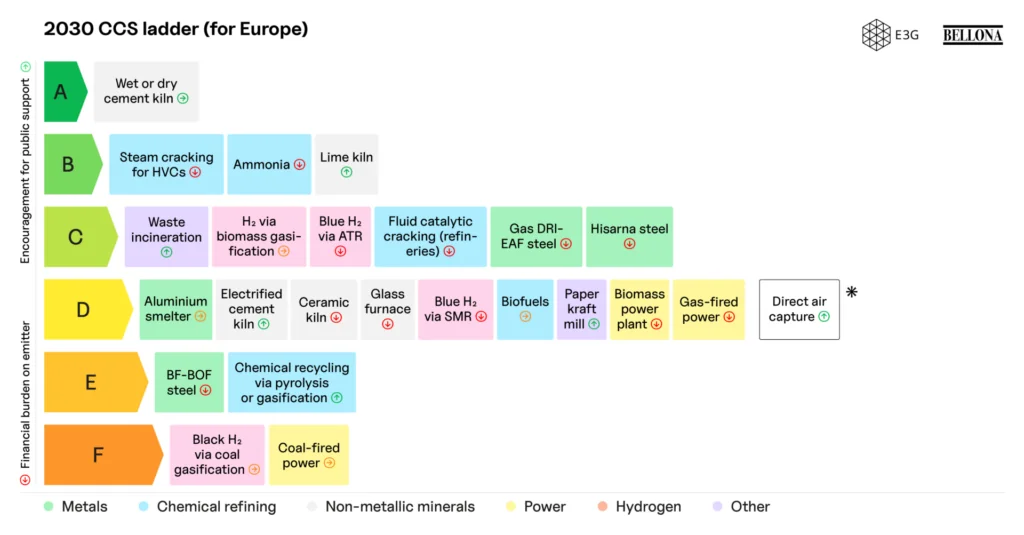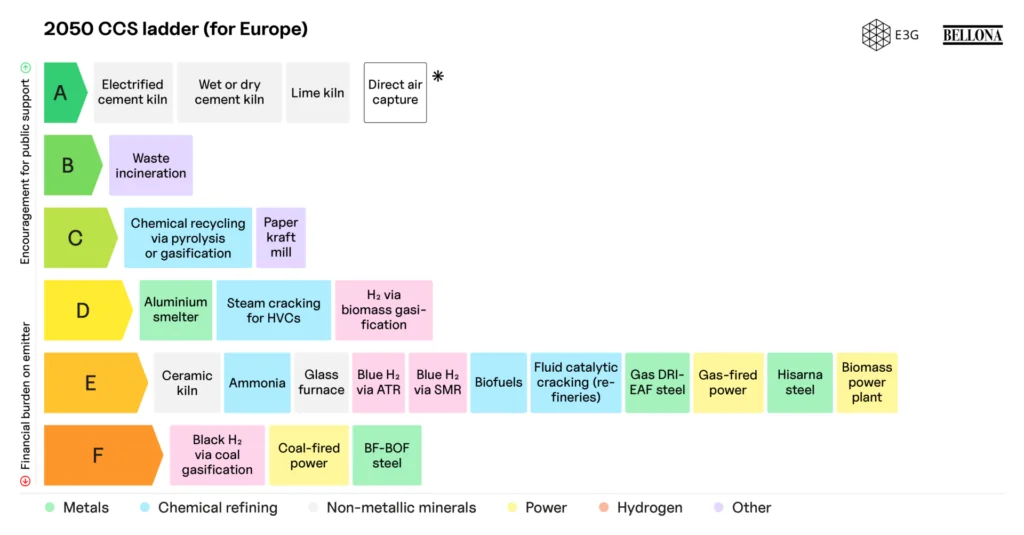Together with Bellona and independent co-authors, E3G has published a “CCS Ladder” for Europe, inspired by the ladder for clean hydrogen by Liebreich Associates. It proposes a methodology & tool to policymakers and stakeholders to assess the value of different CCS applications. Its aim is to bring nuance into the debate and help break the dichotomy between CCS opponents and proponents.
Carbon Capture and Storage (CCS) policy frameworks are being rapidly developed across Europe as the continent moves into an era of deep decarbonisation. Most pathways agree that this transition will require at least some CCS deployment. This is happening in a broader context of emerging green industrial policy approaches featuring increased market intervention, regulation, and subsidies.
At the same time, the carbon capture debate lacks nuance, with CCS often perceived as a single technology with clear supporters and opponents. In reality, some CCS applications can contribute to a shift towards a climate-neutral economy while other applications have a higher risk of delaying real progress. In this context, there is a need to identify where CCS may deliver the greatest climate value and where alternatives should be prioritised.
This briefing proposes a methodological framework for assessing the climate value of different CCS applications in Europe through the creation of a ‘CCS Ladder’. To construct the ladder, a range of CCS applications are ranked across four criteria: 1) Competition from alternative technologies; 2) Mitigation potential; 3) Feasibility; and 4) CO2 source
In short, we argue CCS is most valuable for industrial processes which align with all of the following conditions, where:
- There are limited alternatives for deep decarbonisation/defossilisation;
- CCS has a significant emissions reduction potential;
- CCS has (relatively) limited feasibility challenges to scale and deliver emission reductions based on costs, location and/or size of individual CO2 sources; and
- CCS has limited negative side effects such as fossil fuel lock-in.
The CCS Ladder proposes a methodology/tool to policymakers and stakeholders to assess the value of CCS. Its aim is to bring nuance into the debate and help break the dichotomy between CCS opponents and proponents.
It can be used to inform debate and support the creation of regulatory frameworks. This can help facilitate the deployment of CCS where it is most needed, while limiting it where it is not.
What the CCS ladder is NOT meant to do:
- Be conclusive – value propositions vary and criteria, and their underlying assumptions, may change over time.
- Denounce the use of CCS anywhere – from a pure climate action perspective, capturing and storing emissions is always better than emitting them.
- Judge whether CCS should or should not be applied on a project-by-project basis.
- The ladder looks at applications in the broad sense.
- The actual value of CCS for individual plants is dependent on plants’ characteristics (age, fuel use, geography, etc.).
Figure 1 – 2030 and 2050 ladder


Notes on the diagrams:
2030/2050 CCS ladder based on scoring of applications against four criteria. Applications are labelled by sector. Coloured arrows indicate the change in rank from 2030 to 2050 (up, down or stable). See disclaimer above on how to interpret the CCS ladder.
The climate value of CCS:
- Is lowest in the power sector and is expected to diminish considerably over time.
- Is greatest for industrial applications with significant process emissions, particularly in non-metallic mineral sectors such as cement and lime. The climate value of CCS for these applications is expected to increase through to 2050 as the full potential of other emission reduction levers like electrification, efficiency improvements, demand reduction and substitution are maxed out.
- Is generally expected to decrease over time for most applications, while becoming increasingly important for helping to achieve negative emissions through direct air capture.
- When assessing the climate value of CCS applications, a holistic approach is required as not all CCS is the same. In the context of deep decarbonisation, assessing the climate value of CCS applications must go beyond a simple ‘emissions reduction to investment ratio’ approach, and account for the whole host of environmental, ecological, financial, and technical feasibility factors.
- European policymakers need to undertake their own robust assessments to determine the climate value of different CCS applications. These assessments should be based on objective and transparent criteria, established through input from all concerned stakeholders, and updated regularly considering the overall changing climate value that CCS deployment may have over time.
- European policymakers should target public support to CCS applications with the highest climate value, setting an example for others. Limited public resources and restricted storage injection capacity, especially in the short- to medium-term, further support the logic of targeting public support– both financial and non-monetary – for those applications with the greatest climate value, particularly if their scale-up proves challenging due to technical and regulatory factors. In this context, the European Commission’s proposal in the Net Zero Industry Act to obligate oil and gas producers to make storage injection capacity available should be welcomed, as it alleviates some of the pressure from public finances.
- Accelerated electrification, rapid scale-up of renewables, and increased deployment of energy efficiency and circular solutions are all needed. Overall, the highest value of CCS for climate action can only be achieved if all other measures are deployed at the necessary scale and pace. Drastic reductions in fossil fuel usage, combined with a strong emphasis on energy efficiency and lowering primary energy demand, are necessary to reach climate targets and limit the risk of potential overreliance on CCS which could itself compromise climate objectives.
Read the briefing on the Carbon Capture and Storage Ladder here.
Read the methodology on the Carbon Capture and Storage Ladder here.


